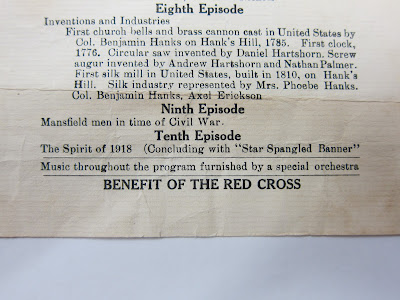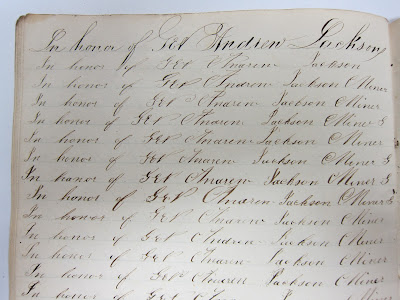On the evening of Tuesday, August 27, 1918, Mansfield residents held a pageant. It was wartime—the Great War would not end for another two and a half months—and the event was held to benefit the Red Cross. The pageant was divided into ten segments, each featuring a different moment from or aspect of Mansfield’s history.
Looking at the event’s program today, we can supplement the information provided in the flyer (not all of which is true) with information from the Mansfield Historical Society’s comprehensive Chronology of Mansfield, Connecticut: 1702-2002. Here, then, are our elaborations on a few of the pageant’s themes.
Second Episode
Joshua was the third son of Native American Sachem Uncas. In February 1675, Joshua signed his will bequeathing a certain parcel to 16 legatees. (This parcel would later compose the major parts of today’s Windham, Mansfield, Chaplin, Ashford, Hampton, and Scotland.) Joshua died the following year, and in May 1678, the General Court of Connecticut officially granted the legatees rights to the tract.
At a meeting in February 1685, the legatees agreed to settle in three places: Hither Place (today, Windham Center), Ponde Place at Naubesatuck (today, Mansfield Center), and the Valley of Willimantic or Willimantic Falls. Between Hither Place and Ponde Place there would be a “highway.”
Fourth Episode
The town of Windham, which at the time included Hither Place and Ponde Place, was incorporated on May 12, 1692. However, a controversy began to build over town and ecclesiastical meetings. Where should town meetings be held? Was it sensible for Ponde Place residents to travel to the Windham church for each service?
At the request of the townspeople, on March 16, 1699, a committee from the General Court decided that the town should split into two ecclesiastical societies, each with its own meeting house. Three years later, the General Court accepted a request that the Windham territory be divided into two townships. Thus, the following year, in May of 1703, Ponde Place was incorporated as the town of Mansfield.
Fifth Episode
In 1706, proprietors voted to hire a schoolmaster for a period of two months. The schoolmaster would be sustained by and under the direction of the ecclesiastical society. The town divided itself into districts, and the schoolmaster traveled from district to district to teach.
Sixth Episode
On October 18, 1710, Eleazer Williams was ordained pastor of the First Church of Christ in Mansfield (which was established earlier the same year). Among the terms of his employment were the following provisions: a monetary settlement of 160 pounds, a 1,000-acre deed of land with a promise of home-building assistance, and a 40 pound annual salary.
Seventh Episode
As the colonies moved toward war with Britain, Mansfield grew energized for the cause. At a town meeting on September 13, 1774, three delegates were elected to attend a meeting in Hartford “on the interesting Concerns of the present Day.”
At the same meeting, a committee of 13 men was established for the collection of donations to “our Suffering Brethren” in Boston, and a decision was made that money could be taken from the town treasury to gather ammunition for the town.
The next month, on October 10, another town meeting was held at which the “Mansfield Declaration of Freedom” was adopted. This document re-affirmed the townspeople’s allegiance to King George III while vowing to defend “our natural and Constitutional Rights” with “our Lives and Fortunes.”
On April 20, 1775, over 90 Mansfield men marched toward Boston under Lt. Col. Experience Storrs.
Eighth Episode
The pageant’s program mentions several exciting moments in Mansfield’s industrial history.
Benjamin Hanks apprenticed with the famous Norwich clockmaker Thomas Harland. In 1776, he made a tall clock that could play six different melodies. He presented the clock to his father Uriah. The clock stayed in the family for 187 years, after which it was presented to the U.S. State Department for use in the diplomatic reception room.
In 1785, Hanks established a bell and cannon foundry on Hanks Hill. He was among the first in the country to cast church bells and bronze cannon.
In 1810, Horatio and Rodney Hanks erected a 12’ by 12’ building, using their own crude water-powered machinery to run the first silk mill in the country.
Ninth Episode
On September 11, 1862, the 21st Regiment of Connecticut Volunteers left the state to go fight in the Civil War. Out of this regiment, 41 men were from Mansfield.
Altogether, 153 Mansfield men served in the Civil War. According to the Chronology, there were 6 killed; 13 died; 22 wounded; 12 captured; 25 deserted; 48 discharged (for disability or dishonor); and 64 mustered out.
Tenth Episode
The last segment of the Mansfield history pageant was entitled “The Spirit of 1918,” and it concluded with a rendition of the national anthem. This would have been an especially poignant close to the evening, because the Great War was still raging. 81 men from Mansfield served in the war.
Although the war was not fought on American soil, it permeated everyday life for many Americans, including those in Mansfield.
In 1917, for example, more than 500 women attended summer courses on canning and food preservation at the Connecticut Agricultural College. These classes were part of the broader war effort.
The Mansfield history pageant was among other benefits for the Red Cross. Earlier in 1918, on March 21, an Old Folks concert was held at the First Congregational Church featuring about 25 costumed singers and an orchestra. A few months later, on June 22, a strawberry fete was held at Houston’s Hunting Lodge. Both events were for the benefit of the Red Cross.
As the pageant closed with the “Star-Spangled Banner” that late August evening, pageant-goers could not know that the war would end on November 11. What they did know was that dozens of their own men were in danger, and that the country itself might be at stake.
They had gathered to remember the glories of their town; then, the pageant done, they departed to their homes, donning again the familiar darkness of their present.
---
If You’d Like to Learn More:
- Chronology of Mansfield, Connecticut: 1702-2002. Mansfield, Conn.: Mansfield Historical Society, 2003.
- Mansfield Historical Society Archives.
---
Please click here for the Mansfield Historical Society's website, which includes further information about the Society's services, programs, and publications, as well as archived articles and newsletters.



















































